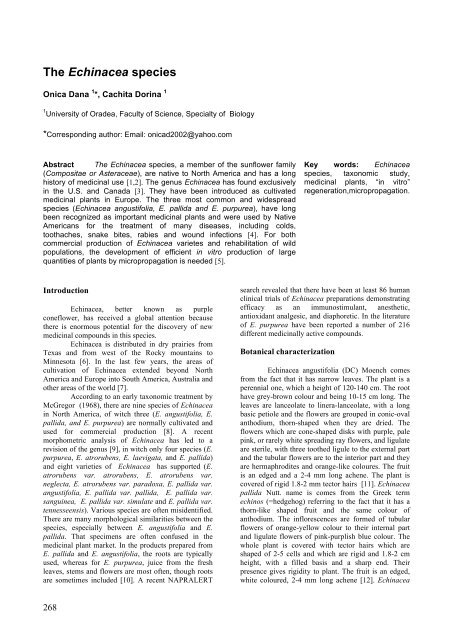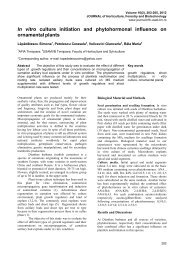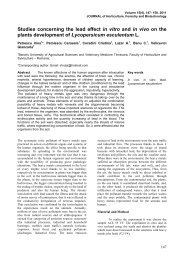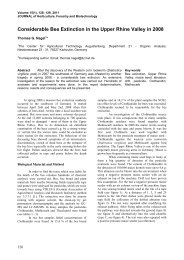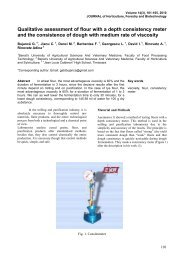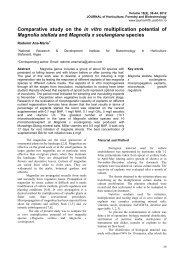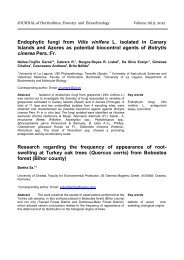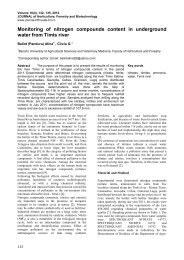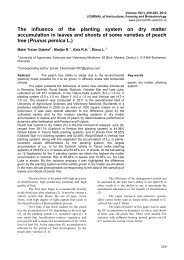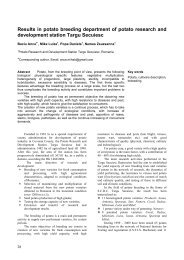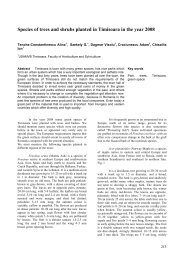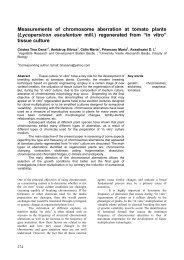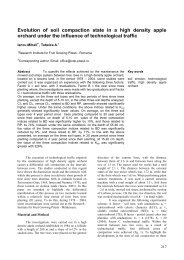The Echinacea species
The Echinacea species
The Echinacea species
You also want an ePaper? Increase the reach of your titles
YUMPU automatically turns print PDFs into web optimized ePapers that Google loves.
<strong>The</strong> <strong>Echinacea</strong> <strong>species</strong><br />
Onica Dana 1 *, Cachita Dorina 1<br />
1 University of Oradea, Faculty of Science, Specialty of Biology<br />
*Corresponding author: Email: onicad2002@yahoo.com<br />
Abstract <strong>The</strong> <strong>Echinacea</strong> <strong>species</strong>, a member of the sunflower family<br />
(Compositae or Asteraceae), are native to North America and has a long<br />
history of medicinal use [1,2]. <strong>The</strong> genus <strong>Echinacea</strong> has found exclusively<br />
in the U.S. and Canada [3]. <strong>The</strong>y have been introduced as cultivated<br />
medicinal plants in Europe. <strong>The</strong> three most common and widespread<br />
<strong>species</strong> (<strong>Echinacea</strong> angustifolia, E. pallida and E. purpurea), have long<br />
been recognized as important medicinal plants and were used by Native<br />
Americans for the treatment of many diseases, including colds,<br />
toothaches, snake bites, rabies and wound infections [4]. For both<br />
commercial production of <strong>Echinacea</strong> varietes and rehabilitation of wild<br />
populations, the development of efficient in vitro production of large<br />
quantities of plants by micropropagation is needed [5].<br />
Key words: <strong>Echinacea</strong><br />
<strong>species</strong>, taxonomic study,<br />
medicinal plants, “in vitro”<br />
regeneration,micropropagation.<br />
Introduction<br />
<strong>Echinacea</strong>, better known as purple<br />
coneflower, has received a global attention because<br />
there is enormous potential for the discovery of new<br />
medicinal compounds in this <strong>species</strong>.<br />
<strong>Echinacea</strong> is distributed in dry prairies from<br />
Texas and from west of the Rocky mountains to<br />
Minnesota [6]. In the last few years, the areas of<br />
cultivation of <strong>Echinacea</strong> extended beyond North<br />
America and Europe into South America, Australia and<br />
other areas of the world [7].<br />
According to an early taxonomic treatment by<br />
McGregor (1968), there are nine <strong>species</strong> of <strong>Echinacea</strong><br />
in North America, of witch three (E. angustifolia, E.<br />
pallida, and E. purpurea) are normally cultivated and<br />
used for commercial production [8]. A recent<br />
morphometric analysis of <strong>Echinacea</strong> has led to a<br />
revision of the genus [9], in witch only four <strong>species</strong> (E.<br />
purpurea, E. atrorubens, E. laevigata, and E. pallida)<br />
and eight varieties of <strong>Echinacea</strong> has supported (E.<br />
atrorubens var. atrorubens, E. atrorubens var.<br />
neglecta, E. atrorubens var. paradoxa, E. pallida var.<br />
angustifolia, E. pallida var. pallida, E. pallida var.<br />
sanguinea, E. pallida var. simulate and E. pallida var.<br />
tennesseensis). Various <strong>species</strong> are often misidentified.<br />
<strong>The</strong>re are many morphological similarities between the<br />
<strong>species</strong>, especially between E. angustifolia and E.<br />
pallida. That specimens are often confused in the<br />
medicinal plant market. In the products prepared from<br />
E. pallida and E. angustifolia, the roots are typically<br />
used, whereas for E. purpurea, juice from the fresh<br />
leaves, stems and flowers are most often, though roots<br />
are sometimes included [10]. A recent NAPRALERT<br />
search revealed that there have been at least 86 human<br />
clinical trials of <strong>Echinacea</strong> preparations demonstrating<br />
efficacy as an immunostimulant, anesthetic,<br />
antioxidant analgesic, and diaphoretic. In the literature<br />
of E. purpurea have been reported a number of 216<br />
different medicinally active compounds.<br />
Botanical characterization<br />
<strong>Echinacea</strong> angustifolia (DC) Moench comes<br />
from the fact that it has narrow leaves. <strong>The</strong> plant is a<br />
perennial one, which a height of 120-140 cm. <strong>The</strong> root<br />
have grey-brown colour and being 10-15 cm long. <strong>The</strong><br />
leaves are lanceolate to linera-lanceolate, with a long<br />
basic petiole and the flowers are grouped in conic-oval<br />
anthodium, thorn-shaped when they are dried. <strong>The</strong><br />
flowers which are cone-shaped disks with purple, pale<br />
pink, or rarely white spreading ray flowers, and ligulate<br />
are sterile, with three toothed ligule to the external part<br />
and the tubular flowers are to the interior part and they<br />
are hermaphrodites and orange-like coloures. <strong>The</strong> fruit<br />
is an edged and a 2-4 mm long achene. <strong>The</strong> plant is<br />
covered of rigid 1.8-2 mm tector hairs [11]. <strong>Echinacea</strong><br />
pallida Nutt. name is comes from the Greek term<br />
echinos (=hedgehog) referring to the fact that it has a<br />
thorn-like shaped fruit and the same colour of<br />
anthodium. <strong>The</strong> inflorescences are formed of tubular<br />
flowers of orange-yellow colour to their internal part<br />
and ligulate flowers of pink-purplish blue colour. <strong>The</strong><br />
whole plant is covered with tector hairs which are<br />
shaped of 2-5 cells and which are rigid and 1.8-2 cm<br />
height, with a filled basis and a sharp end. <strong>The</strong>ir<br />
presence gives rigidity to plant. <strong>The</strong> fruit is an edged,<br />
white coloured, 2-4 mm long achene [12]. <strong>Echinacea</strong><br />
268
purpurea (L.) Moench is bush-like shaped, with 80-<br />
100 cm height. Its roots have many ramifications<br />
which are oblique positioned and they are light-brown<br />
coloured. <strong>The</strong> stem has red coloured basis and ends and<br />
oval-lanceolate, 5-nervation leaves, the basic ones<br />
being long petiolate and the top ones are sessile and<br />
short petiolate.<br />
<strong>The</strong> flowers are grouped in inflorescences<br />
anthodium. <strong>The</strong>se ones are large, having the involucre<br />
shaped of three types of folioles. <strong>The</strong> ligules are<br />
intensely red coloured and the frit is represented by an<br />
edged achene, white coloured, with a rudimentary<br />
pappus, coronule shaped and having a 3-5 mm size.<br />
<strong>The</strong> plant has short, rigid hairs.<br />
Fig.3 Structure of caftaric acid C 13 H 12 O 9<br />
Fig. 4 Structure of chlorogenic acid C 16 H 18 O 9<br />
Secundary metabolites of <strong>Echinacea</strong><br />
Higher plants produce a great variety of<br />
secondary metabolites, which have been used as<br />
pharmaceuticals, nutraceuticals and food additives.<br />
Recent advance in the techniques and applications of<br />
plant cell and organ cultures have made it possible to<br />
produce these valuable secondary metabolites in large<br />
scale. Moreover, plant cell culture system provide<br />
various ways to boost yields of desired metabolites,<br />
conveniently and cost effectively [13]. <strong>Echinacea</strong><br />
purpurea is a medicinal plant, which has shown<br />
antioxidative, antibacterial, antiviral and antifungal<br />
properties, and is used in the tratment for common<br />
cold, as well as respiratory and urinary diseases [14].<br />
<strong>The</strong> main bioactive constituents are caffeic acid<br />
derivatives (Fig. 1), alkylamides, polyacetylenes and<br />
polysaccharides [15]. Whith regard to caffeic acid<br />
derivatives, several compounds have been identified<br />
from hydrophilic fraction of E. purpurea, which<br />
revealed that caftaric acid (Fig. 3), chichoric acid (Fig.<br />
2) and chlorogenic acid (Fig. 4) are the important ones.<br />
Fig. 1 Structure of caffeic acid C 9 H 8 O 4<br />
Fig. 2 Structure of cichoric acid C 22 H 18 O 12<br />
<strong>Echinacea</strong> biotechnology<br />
For rehabilitation of wild population of<br />
<strong>Echinacea</strong> varietes and for comercial production of<br />
<strong>Echinacea</strong> <strong>species</strong>, the development of efficient in<br />
vitro production of large quatities of plants by<br />
micropropagation is nedeed. Regeneration of mature<br />
shoots from callus and suspension cultures is a critical<br />
requirement for the application of in vitro selection [5].<br />
In vitro tissue culture of <strong>Echinacea</strong> can play a<br />
vital role in the development of novel germplasm,<br />
rapid multiplication, and genetic modification for an<br />
enhanced phytochemical production.<br />
Recent establishment of liquid culture<br />
techniques, large-scale bioreactors, and<br />
Agrobacterium-mediated transformation are changing<br />
the production parameters of the <strong>Echinacea</strong> <strong>species</strong><br />
[16]. A new method provides an efficient system of<br />
adventitious shoot regeneration from leaf explants of<br />
E. purpurea that will useful for micropropagation of<br />
elite ornamental or chemotype selection of this<br />
medicinal <strong>species</strong>. In addition, this regeneration<br />
system, combined with Agrobacterium transformation,<br />
provides a method for routine genetic transformation of<br />
this important medicinal <strong>species</strong>.<br />
Micropropagation of three <strong>Echinacea</strong> <strong>species</strong>,<br />
E. purpurea Moench., E. angustifolia DC., and E.<br />
pallida Nutt., was investigated as a potential means of<br />
germplast preservation of <strong>species</strong> faced with<br />
overcollection in the wild and rapid clonal propagation<br />
of elite individuals with unique medicinal or<br />
ornamental properties. Very high contamination rates<br />
occured with shoot-tip explants but not with nodal<br />
segments [17].<br />
269
In vitro regeneration and production offers<br />
many advantages for the growth of medicinal plants in<br />
general and more specifically <strong>Echinacea</strong> as it offers the<br />
capacity to optimize all growth conditions [18].<br />
<strong>The</strong>re have been several previous reports of in<br />
vitro regeneration in the literature from E. purpurea<br />
and E. tennesseensis - Coker and Camper, 1999;<br />
Choffe et al., 2000; Koroch et al., 2002; Mechanda et<br />
al., 2003; Zobayed and Saxena, 2003; Sauve et al.,<br />
2004; Jones et al., 2006 - and two reports of<br />
agrobacterium-mediated transformation in this <strong>species</strong><br />
- Koroch et al., 2002b; Wang and To, 2004 - however,<br />
a wide range of different responses have been observed<br />
in explants cultured on identical culture medium and<br />
Conclusions<br />
1. Important morphological and anatomical<br />
characteristics of <strong>Echinacea</strong> plants are<br />
described for the purpose of<br />
pharmacognostical identification of the drugs.<br />
2. Direct multiple shoot production from leaf<br />
explants is critical to produce a large number<br />
of uniform plants from the elite lines of<br />
mature E. purpurea plants.<br />
3. <strong>The</strong> high efficiency regeneration method from<br />
mature plants of E. purpurea is useful for the<br />
evaluation of native populations for desired<br />
chemicals. This will help in developing<br />
regeneration protocols for the near-extinct<br />
varietes and other <strong>species</strong> of <strong>Echinacea</strong>.<br />
4. Other <strong>Echinacea</strong> <strong>species</strong> have been<br />
propagated in vitro from root, hypocotyls,<br />
cotyledon, stem and from leaf explants. That<br />
study was undertaken to develop a<br />
regeneration protocol for the mass<br />
propagation and preservation of the rare<br />
<strong>Echinacea</strong> <strong>species</strong>.<br />
5. <strong>The</strong> plant production can be scheduled<br />
throughout the year since the entire process is<br />
completed in a controlled environment<br />
ensuring a year round supply of high quality<br />
product as well as increasing the economic<br />
viability for the producer.<br />
References<br />
1. Shemluck, M., 1982 – Medicinal and other<br />
uses of the Compositae by Indians in<br />
the United States and Canada – Journal<br />
of Ethnopharmacology 5: 303-358;<br />
2. Bauer, R. 1998 - Standardization of<br />
<strong>Echinacea</strong> purpurea expressed juice<br />
with reference to cichoric acid and<br />
alkamides. J. Herbs Spices Med. Plants<br />
loc.cit.<br />
3. McGregor RL, 1968 - <strong>The</strong> taxonomy of the<br />
genus <strong>Echinacea</strong> (Compositae). Univ.<br />
of Kansas Sci. Bul.;48:113–142<br />
there has been no systematic study of the chemical<br />
diversity among regenerated plants [18].<br />
Micropropagation offers an approach that is<br />
capable of producing large number of genetically<br />
similar, disease free plants in a short period of time and<br />
limited space [19]. Although there are several reports<br />
of in vitro regeneration of E. purpurea, they have all<br />
been conducted using solid media, and could be further<br />
improved by developing a liquid-based system<br />
[20,21,22,5,23].<br />
4. Bauer, R. and H. Wagner, 1991 - <strong>Echinacea</strong><br />
<strong>species</strong> as potential immunostimulatory<br />
drugs. In: H. Wagner and N.R.<br />
Farnsworth (eds.), Economic and<br />
medicinal plant research. Academic<br />
Press, New York, Vol. 5/8. p. 253–321.<br />
5. Mechanda, S. M., B. R. Baum, D. A. Johnson<br />
and J. T. Arnason, 2003 - Direct shoot<br />
regeneration from leaf segments of<br />
mature plants of <strong>Echinacea</strong> purpurea<br />
(L.) Moench. In Vitro Cell. Dev. Biol.<br />
Plant 39:505–509.<br />
6. Bauer, R. and S. Foster. 1991 - Analysis of<br />
alkamides and caffeic acid derivatives<br />
from <strong>Echinacea</strong> simulata and E.<br />
paradoxa roots. Planta Med. 57:447–<br />
449.<br />
7. Yu, H. C. and M. Kaarlas 2004 - Popularity,<br />
diversity, and quality of <strong>Echinacea</strong>. In<br />
Miller, S., editor. (ed). <strong>Echinacea</strong>. <strong>The</strong><br />
genus <strong>Echinacea</strong>. CRC Press. Boca<br />
Raton, FL. pp. 29–52.<br />
8. Cox, P. B. and L. E. Urbatsch, 1990 - A<br />
phylogenetic analysis of the coneflower<br />
genera. Syst. Bot. 15:394–402<br />
9. Binns SE, Baum BR, Arnason JT, 2002a - A<br />
taxonomic revision of <strong>Echinacea</strong><br />
(Asteraceae: Heliantheae). Syst<br />
Bot.;27:610–632<br />
10. Schulz V, Hansel R, Tyler VE, 2000 -<br />
Rational Phytotherapy. Berlin<br />
(Germany): Springer-Verlag Berlin<br />
Heidelberg,.<br />
11. Muntean L., Salontai A. , Tamas M. , Botez<br />
C., Vaida F., 1989 - Research on the<br />
biology of <strong>Echinacea</strong> angustifolia (Dc.)<br />
Moench and <strong>Echinacea</strong> purpurea (L.)<br />
Moench, Zeitraum1976 – 2001,<br />
ScientifiCcommons.<br />
12. Muntean L., Salontai A., Botez C., Tamas M.,<br />
Cernea S., Morar G., Vaida F., 1991 -<br />
Research on the biology of <strong>Echinacea</strong><br />
pallida Nutt. and <strong>Echinacea</strong> purpurea<br />
(L.) Moench (II), Zeitraum1976 – 2001,<br />
ScientifiCcommons<br />
270
13. Rao, R.N., T. Ravisankar & K. Satyanarayana<br />
R., 2002 - Ethnobotany-an essential<br />
tool for biodiversity conservation.<br />
National Workshop on Peoples<br />
Participatory Approaches in<br />
Conservation and Management of<br />
Forest Resources held at Kakinada,<br />
Andhra Pradesh, India, M. S.<br />
Swaminathan Research Foundation,<br />
Kakinada and FAO<br />
14. Barrett B. - Medicinal properties of<br />
<strong>Echinacea</strong>: a critical review,<br />
Phytomedicine. 2003 Jan;10(1):66-86<br />
15. Bauer R, Hoheisel O, Stuhlfauth I, Wolf H.,<br />
1999 - Extract of the <strong>Echinacea</strong><br />
purpurea herb: an allopathic<br />
phytoimmunostimulant, Wien Med<br />
Wochenschr.;149(8-10):185-9<br />
16. Abbasi, B. H., C. L. Tian, S. J. Murch, P. K.<br />
Saxena, and C. Z. Liu, 2007 - Light<br />
enhanced caffeic acid derivatives<br />
biosynthesis in hairy root cultures of<br />
<strong>Echinacea</strong> purpurea. Plant Cell Rep (in<br />
press). DOI 10.1007.<br />
17. Harbage, J. F., 2001 - Micropropagation of<br />
<strong>Echinacea</strong> angustifolia, E. pallida, and<br />
E. purpurea from stem and seed<br />
explants. HortScience 36:360–364.<br />
18. Murch, S. J., S.E. Peiris, W.L. Shi, S.M.A.<br />
Zobayed, P.K. Saxena, 2006 – Genetic<br />
diversity in seed populations of<br />
<strong>Echinacea</strong> purpurea controls the<br />
capacity for regeneration, route of<br />
morphogenesis and phytochemical<br />
composition. Plant Cell Report. 25:522-<br />
532.<br />
19. Jones, M.P.A., Z Yi, SJ Murch, PK Saxena,<br />
2007 - Thidiazuron-induced<br />
regeneration of <strong>Echinacea</strong> purpurea L.,<br />
Plant Cell Reports.<br />
20. Choffe, L. L., S. J. Murch, and P. K. Saxena.<br />
2000 - Regeneration of <strong>Echinacea</strong><br />
purpurea: induction of root<br />
organogenesis from hypocotyls and<br />
cotyledon explants. Plant Cell Tiss.<br />
Organ Cult. 62:227–234<br />
21. Koroch, A., H.R. Juliani, J. Kapteyn, and J.E.<br />
Simon, 2001 - In vitro regeneration of<br />
<strong>Echinacea</strong> purpurea from leaf explants.<br />
Plant Cell Tissue Organ Culture.<br />
22. Lakshmanan, P., M. Danesh, and A. Taji.<br />
2002 - Production of four commercially<br />
cultivated <strong>Echinacea</strong> <strong>species</strong> by<br />
different methods of in vitro<br />
regeneration. J. Hort. Sci. Biotechnol.<br />
77:158–163.<br />
23. Zobayed, S. M A. and P. K. Saxena. 2003 -<br />
In vitro-grown roots: a superior<br />
explant for prolific shoot regeneration<br />
of St. John's wort (Hypericum<br />
perforatum L. cv ‘New Stem) in a<br />
temporary immersion bioreactor. Plant<br />
Sci. 165:463–470<br />
271


